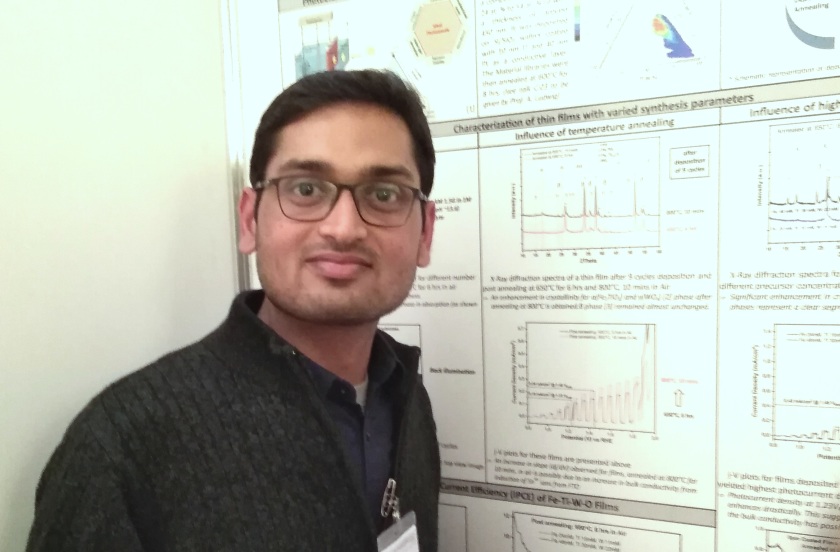Posterprize for HZB postdoc Prince Saurabh Bassi

Bassi presented results on new phases in the quaternary Fe-Ti-W-O system for application as photoelectrocatalyst in light-assisted water splitting. © HZB
Dr. Prince Saurabh Bassi was awarded the poster prize at “International Bunsen-Discussion-Meeting on Fundamentals and Applications of (Photo) Electrolysis for Efficient Energy Storage”. He is a postdoctoral fellow working with Prof. Sebastian Fiechter in the Institute for Solar Fuels.
The poster was titled: “Survey and Synthesis of Photoactive Phases in the Quaternary System Fe-Ti-W-O Supported by Combinatorial Screening Experiments”. It was chosen from 53 posters presented during two poster sessions of the conference with 150 participants. The meeting was held in Taormina, Italy from 1st to 5th April 2019. The prize was sponsored by the Royal Society of Chemistry (Journal of Materials Chemistry A, B and C and Materials Horizons). A book voucher was also gifted to him by the society.
In the poster, Bassi presented latest results on the survey and synthesis of new phases in the quaternary Fe-Ti-W-O system for application as photoelectrocatalyst in light-assisted water splitting. The inability to find systems possessing favorable characteristics like optimum band gap for efficient solar light absorption and electrochemical, aqueous and thermodynamic stability, have led the scientific community to explore complex ternary and quaternary oxide systems. Since they encompass complimentary properties of their constituent binary oxides, their properties can be tuned by varying their stoichiometry.
He fabricated thin film photoelectrodes of the hit composition Fe48Ti30W22Ox, obtained from the combinatorial screening, using a simple spin coating route. The structural analysis revealed that - after temperature annealing – a new quaternary oxide appeared crystallizing in a distorted Ferberite structure together with the ternary phases Fe2TiO5 and Fe1.7Ti0.23O3. His work proves to be a bridge between combinatorial studies and thin film fabrication and characterization of photoactive hit region compositions.
red.
https://www.helmholtz-berlin.de/pubbin/news_seite?nid=20488;sprache=en
- Copy link
-
Sodium-ion batteries: New storage mechanism for cathode materials
Li-ion and Na-ion batteries operate through a process called intercalation, where ions are stored and exchanged between two chemically different electrodes. In contrast, co-intercalation, a process in which both ions and solvent molecules are stored simultaneously, has traditionally been considered undesirable due to its tendency to cause rapid battery failure. Against this traditional view, an international research team led by Philipp Adelhelm has now demonstrated that co-intercalation can be a reversible and fast process for cathode materials in Na-ion batteries. The approach of jointly storing ions and solvents in cathode materials provides a new handle for the designing batteries with high efficiency and fast charging capabilities. The results are published in Nature Materials.
-
Helmholtz Doctoral Award for Hanna Trzesniowski
During her doctoral studies at the Helmholtz Centre Berlin, Hanna Trzesniowski conducted research on nickel-based electrocatalysts for water splitting. Her work contributes to a deeper understanding of alkaline water electrolysis and paves the way for the development of more efficient and stable catalysts. On 8 July 2025, she received the Helmholtz Doctoral Prize, which honours the best and most original doctoral theses in the Helmholtz Association.
-
New department at HZB: ‘AI and Biomolecular Structures’
Since 1 July 2025, Dr. Andrea Thorn has been setting up the new AI and Biomolecular Structures department at HZB. A biophysicist with many years of experience in AI-based tools for structural biology, she is looking forward to collaborating closely with the macromolecular crystallography team at the MX beamlines of BESSY II.
